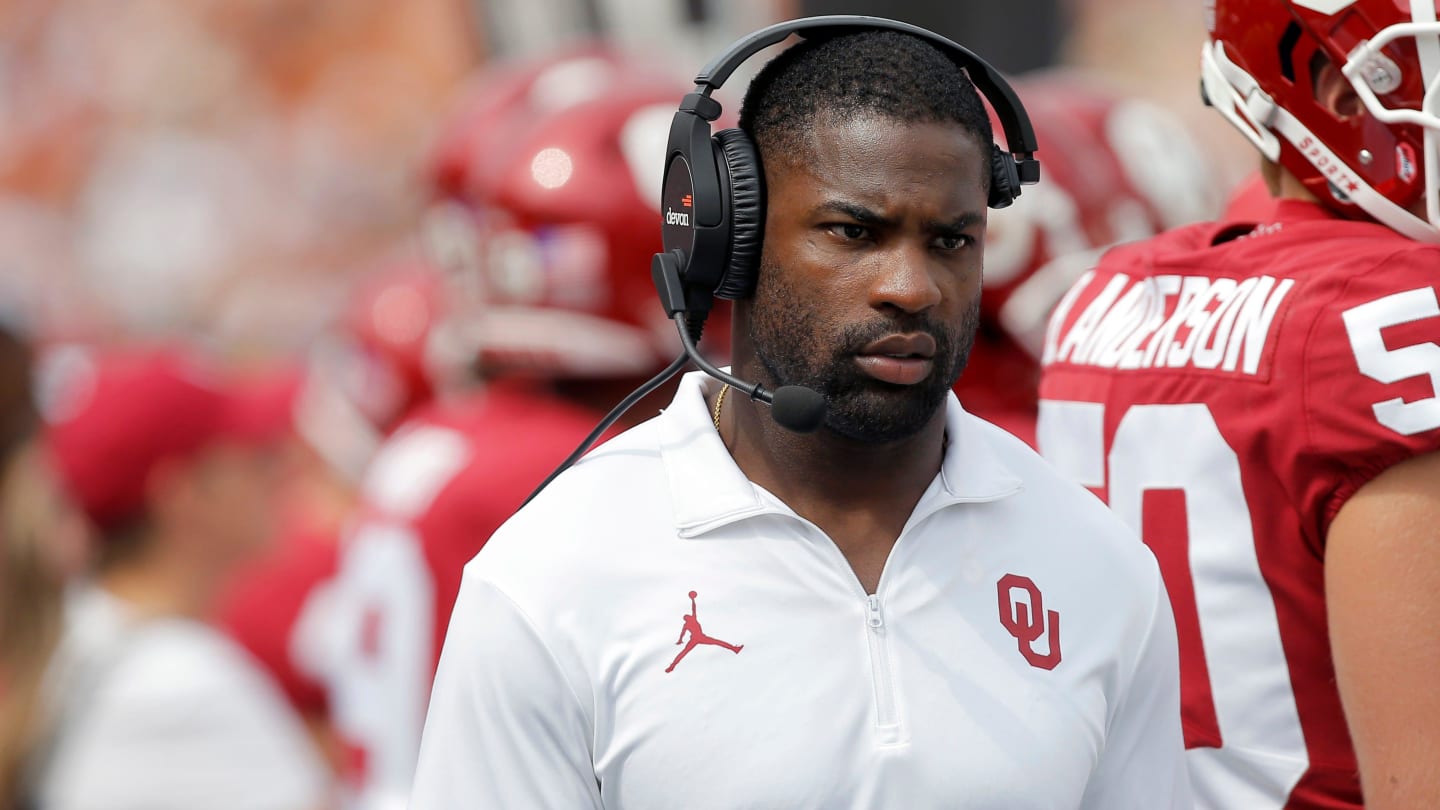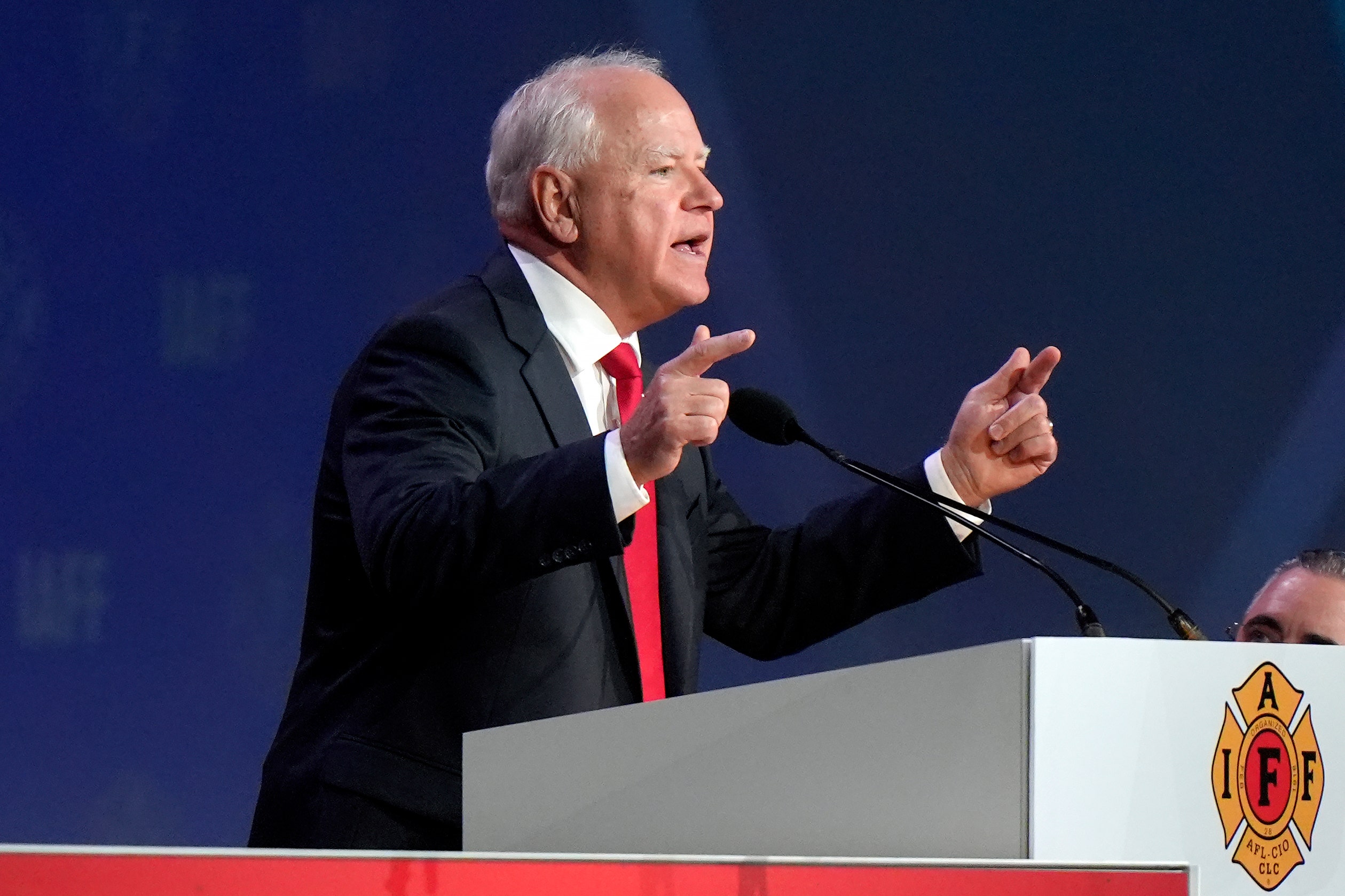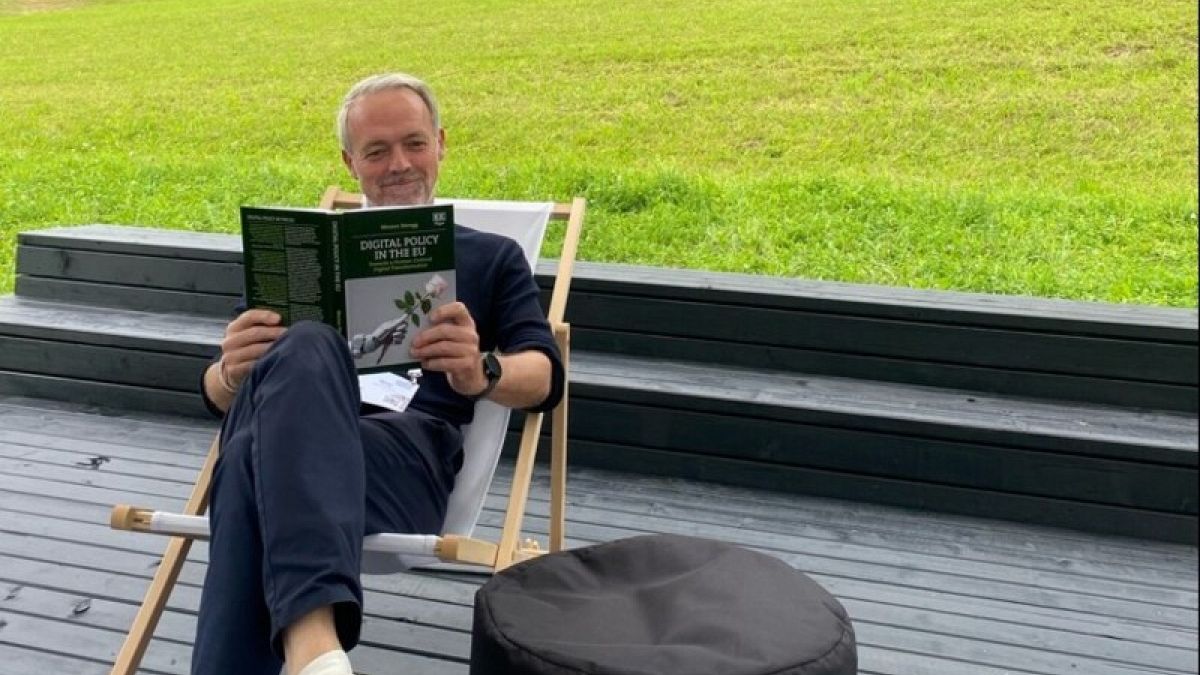Entertainment
ShyBelligerent, reformed pimp turned rapper, shines a light on vulnerability in L.A. hip-hop
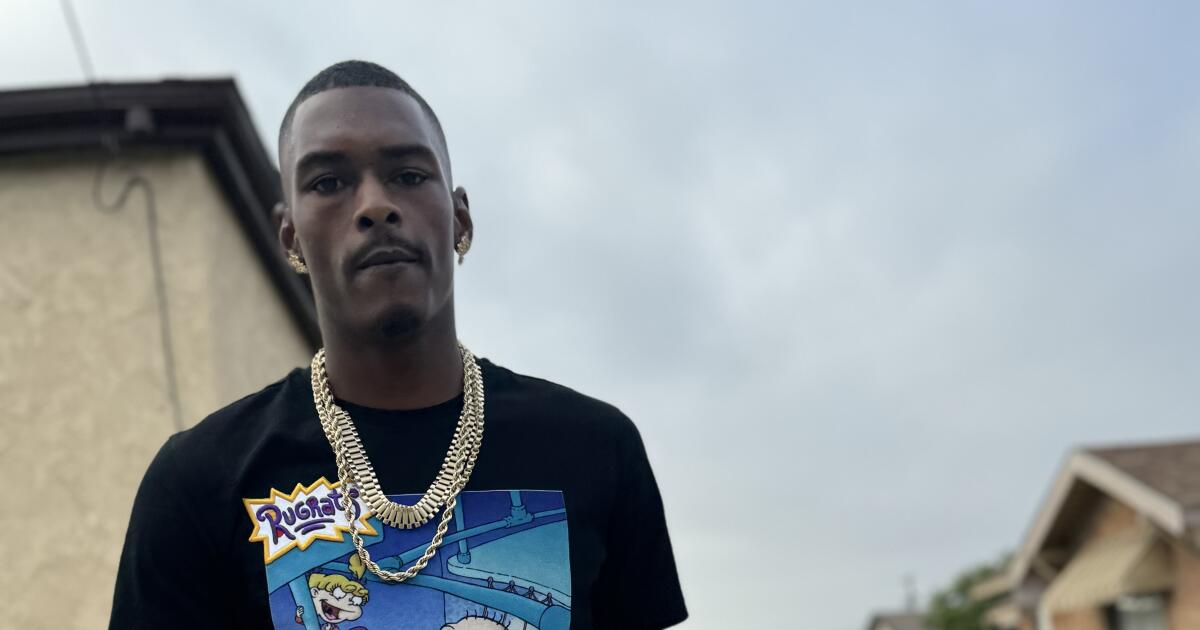
ShyBelligerent is hurting.
You can see it in his videos, where he paces helplessly through cemeteries and city streets and unfurnished bedrooms. You can hear and feel it in his voice. The 30-year-old rapper born Michael William, who is rail-thin with sharp, angular features and a pencil mustache, is also fearless on the page. He writes about all that’s been done to him, and all that he’s had to do.
“I can’t forget about the past,” he wails on his latest album, “It’s a Ugly Come Up.” “Where the Hennessey at? I’m finna down that. My whole life, I’ve been down bad.” The beats, mostly piano-based, are exquisitely complementary. Shy himself is movingly human — full of vim but also lonesome and afraid.
“I got to plot it out,” Shy says of the new album. “I actually got to make it a great project.” Much of his previous work was rushed and improvised. This time around, though, Shy took his sweet time. Lyrically and thematically, “It’s a Ugly Come Up” is focused without infringing too much on the spontaneity that has become Shy’s trademark.
For Shy, lyrics are of secondary importance. His power is in his voice — a twitchy, erratic, untethered yelp — that reveals him not as a victim, but as a vessel of chronic pain. The Compton native says he is tormented by what he’s experienced or, more to the point, what he can’t un-experience. How appropriate that Shy tweets under the handle “@sbbenthroughit.”
His song “Cry Me a River,” is a desperate airing of grievances. Thus far, “River” is the most viral song Shy has ever made (156,000 YouTube views and counting).
“In the L.A. music scene, my problem as a producer is that everybody sounds like everybody else,” says TooRawEntertainment, Shy’s producer who sends him beats from his studio in Arizona. “[Shy] definitely stands out. His delivery is crazy and his energy is even crazier. And he tells the truth, for real, in his raps.”
The “Cry Me a River” video captures the L.A. rapper flopping around in a raggedy tent adjoining a rail yard. Shy is not unhoused — he is in fact a very vocal tenant of the Housing Authority of the City of Los Angeles, better known as HACLA. Though he has a place to stay, at times he seems lost in his chaotic interior world. In conversation, the rapper lives up to the implied duality in his name — alternating between quiet and rambunctious. But if you only know him through his music, nothing can prepare you for just how demure and put-together he is in real life.
“I think it’s one of the most remarkable things about him,” says DeJon Paul, a rap critic and blogger from Inglewood who is also a regular on the popular hip-hop podcast “No Jumper.” His local gravitas provides a refreshing contrast to “No Jumper” host Adam22. Each year Paul rolls out the local equivalent of XXL magazine’s Freshman Class list. Shy was one of the chosen few in 2023.

In conversation, ShyBelligerent lives up to the implied duality in his name — alternating between quiet and rambunctious.
(David McGriff)
“He has this bombastic personality on wax and in his videos,” Paul said. “ But when you hang out with him or when you interview him, when you run into him in public, he’s quiet, stoic, he’s to himself, he’s reserved.” The explanation for that lies in Shy’s upbringing.
“It wasn’t your typical mother-father scenario,” Shy says. “My mother was supposed to fight for me, but she just wasn’t able to.” His mother walked out when he was an infant. His unstable father was not any better prepared for parenthood. As a child he was “signed over” to his stern, churchgoing grandmother and jazz-enthusing grandfather. Shy remained in their care until he was 15.
Some good came of this familial arrangement. His grandfather instilled in him a musical curiosity that persists to the present day (“That’s why my style is so unique”). But Shy was a cowed and glum child. His world, small to begin with, shrank by two when his parents left his life. He couldn’t make sense of it. The more he fumbled for answers, the more overwhelmed he became by entropy and uncertainty.
“Later down the line,” Shy says now, “I was able to speak up and ask questions and figure things out.” But in grieving his lost youth, he became quarrelsome and sometimes belligerent. Shy’s trajectory is all too familiar: frightened, neglected boys often become angry men.
For a time he sought release and restoration in the classroom (his favorite course was Honors English). The gridiron was another precious sanctuary; Shy played defensive end on the Compton High football team. Even then, however, he had designs on a rap career; it was around 2009 when he got serious about his craft. L.A. is a networker’s paradise and Shy likes to network, but he didn’t always. His teenage apprenticeship was completely informal and self-supervised.

“This was when YG was in his prime,” Shy says. At the time, YG was an up-and-coming wiry truth-teller, a fellow Compton rapper who turned into a superstar and provided Shy with a blueprint of how to succeed. “I was trying to make a name for myself then, but with the little resources I had, the little knowledge I had at that moment, it was rocky.”
William had at his disposal only the cheapest of equipment — RadioShack microphones and “busted-up laptops.” Eventually he built a functioning studio out of primitive equipment.
If Shy’s creative life suffered, it was because he had competing responsibilities. He fathered a child at 15. This enraged his fundamentalist grandparents, who sent him scrambling for steady work, much like Ice Cube on “A Bird in the Hand.” He worked in dollar stores, warehouses — any place that would pay him a legal wage. Shy’s employment history is largely aboveboard, but he’s done things for money that by his own admission are inexcusably vile.
As Shy’s rapping evolved, so too did his journalistic sense. He began to experiment with the vlogger model of YouTube street reporting. The following he gained from this activity wasn’t huge relative to the biggest vloggers, but it also wasn’t negligible. Shy says he has a knack for timing, for providentially capturing extraordinary scenes as they happen.
On tracks such as “Son of a Bitch,” William recounts a period in his life when he was “pimping hoes.” This isn’t a euphemism nor is it a case of hip-hop fabulism. He has direct experience trafficking women.
“It was for a short amount of time,” he says, while conceding that he was active long enough to inflict lasting damage on the women funneled into his “stable.”
“Having daughters would make you rethink the whole situation,” he says. “I’ve seen a bigger picture now.” These may sound like limp platitudes, but on “Son of a Bitch,” Shy sounds like the most spiritually tortured ex-trafficker in hip-hop history. (Suga Free with a conscience? All jokes aside, their rapping styles are very similar.)
Watts had always functioned as a second home for Shy, and at some point he moved there permanently. In retrospect, Watts was the best place he could’ve gone. Shy’s identity is bound up, almost inextricably, with this close-knit community of 35,000. Would there be a ShyBelligerent if he still were mooning around Compton?
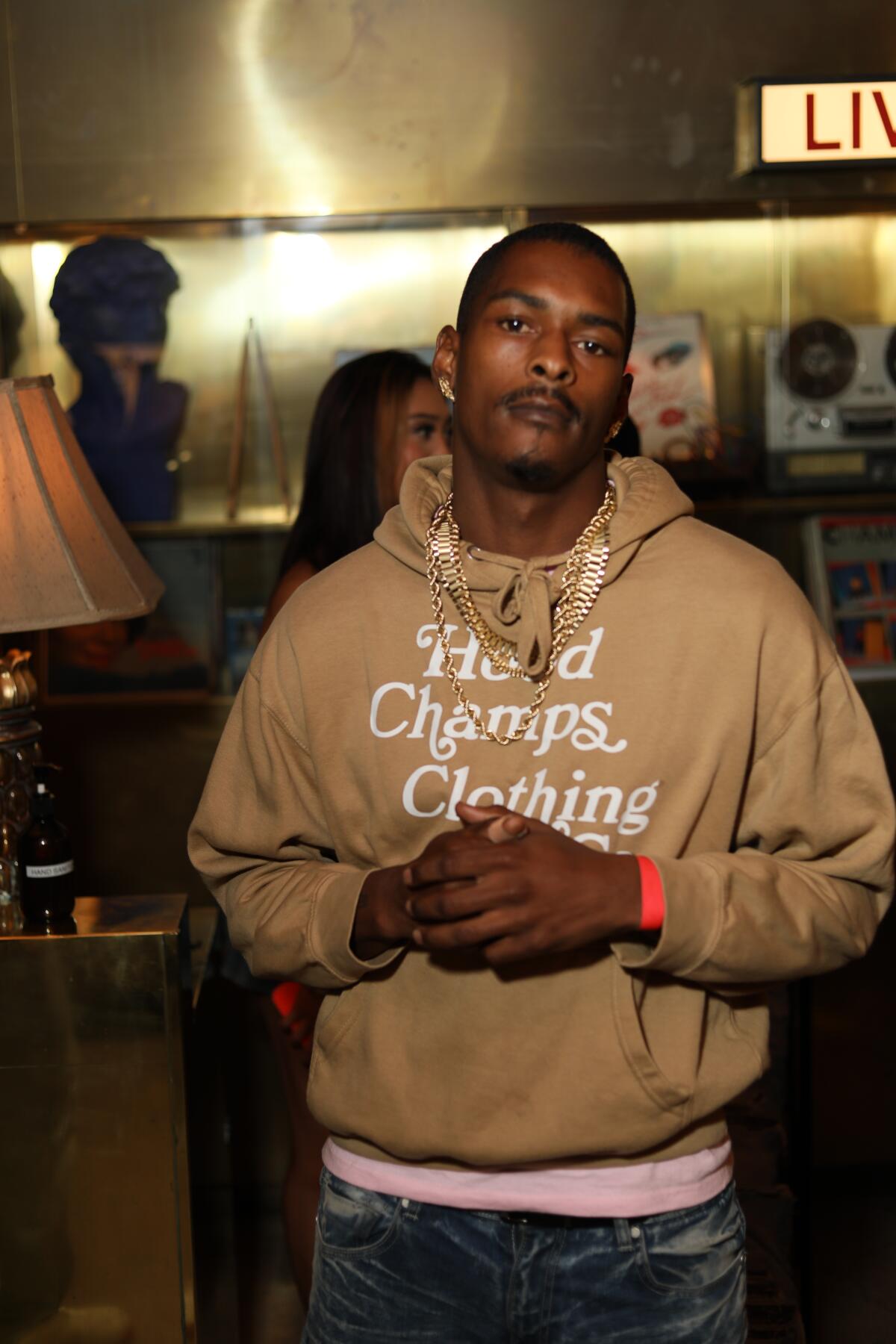
Watts functioned as a second home for ShyBelligerent and at some point he moved there permanently. His identity is bound up, almost inextricably, with the community.
(David McGriff)
Shy’s adopted home is fertile ground for rap talent. He currently lives in the low-slung, lemon-hued Nickerson Gardens apartment complex and identifies intensely with the place. In his X bio, Shy introduces himself as an unsigned artist from Nickerson Gardens. His free agency is a geographic catastrophe, and also an A&R failure, says Paul.
“I’m surprised TDE hasn’t snatched him up,” Paul says, referring to Top Dawg Entertainment, the prestigious label whose roster — Kendrick Lamar, Jay Rock, Schoolboy Q — descends on Nickerson every year for a Christmas jamboree and toy drive.
Therein lies a critical action verb: snatch. Shy is forever snatching defeat from the jaws of victory. He has talent, emotional courage, great sonic instincts (his beat selection is top-notch). But he often seems like an accident waiting to happen. “It’s a Ugly Come Up” is so feral, so brazenly uninhibited, that Schoolboy Q’s “Blue Lips” seems almost family-friendly by comparison.
Any major label would try to soften Shy’s rough edges — and who wants that? Certainly not him. For all the doubt and pain Shy has endured in his 30 years, for all the catastrophic blows to his psyche, he stands by his music. It’s his one source of self-esteem, self-efficacy and pride.
“I’m a musical genius,” he says flatly. Maybe that’s hyperbolic, maybe not, but his dramatic genius isn’t up for debate. In matters of using hip-hop to dramatize human hurt, there’s no question ShyBelligerent is as great as he says he is.

Movie Reviews
1992 movie review & film summary (2024) | Roger Ebert
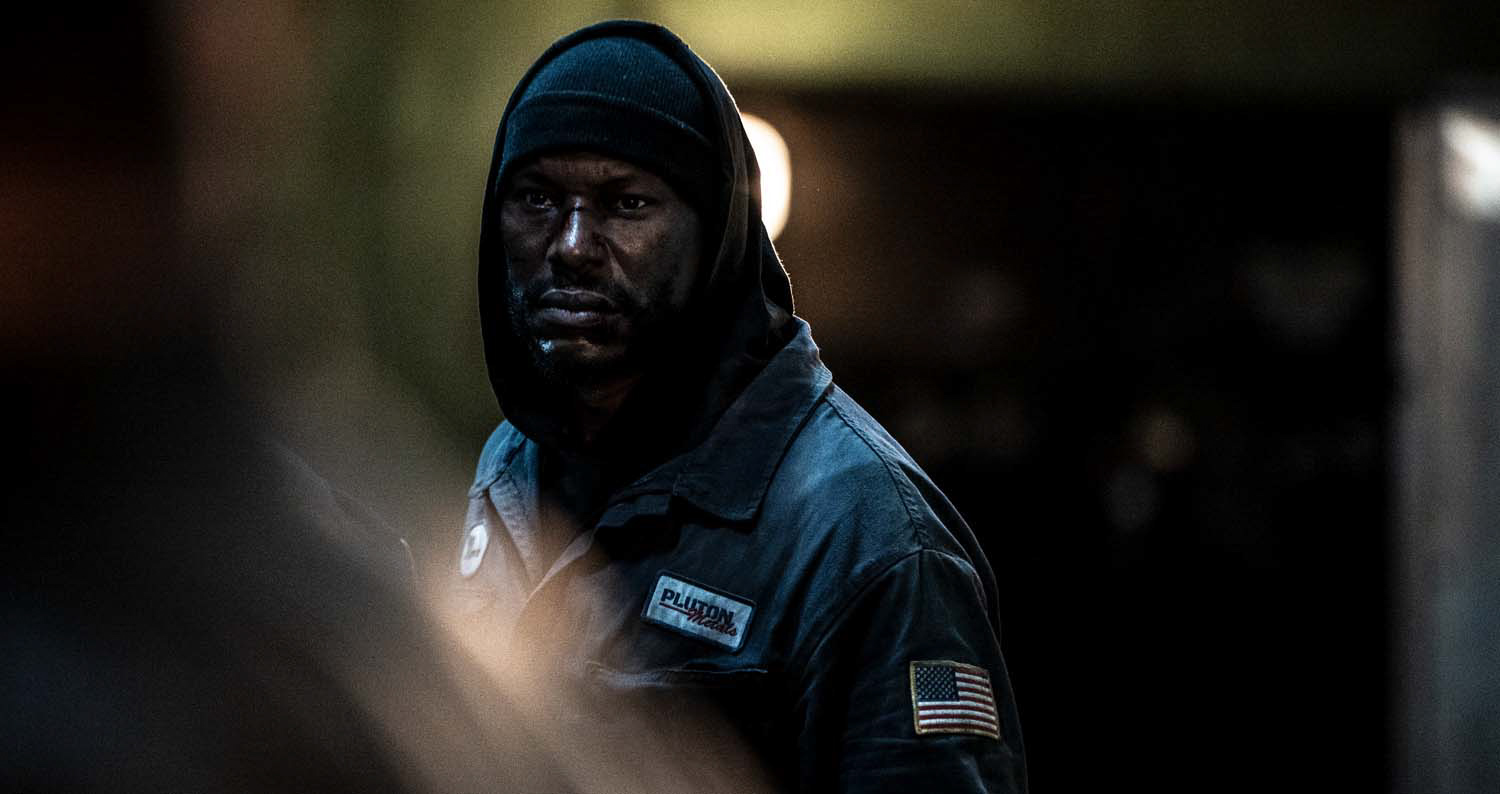
Count “1992” as one of those films with its heart in the right place but its execution in the wrong space. Set on April 29, 1992, the day of the Rodney King verdict, this is a surprisingly uncomplicated film, one that attempts to balance its heist-thriller elements with its combustible racial milieu. It features Tyrese Gibson as a single father named Mercer, working to protect his teenage son Antoine (Christopher Ammanuel) from the surrounding violence only to upset an ensuing robbery led by Lowell (the late Ray Liotta) and his crew. There are shootouts, a car chase, some heroics and some hard life lessons—but this film isn’t breaking new ground on either the action or socio-political front.
Director Ariel Vromen’s “1992” often plays like a significantly lesser mishmash of Kathryn Bigelow’s “Detroit” and John Carpenter’s “Assault on Precinct 13.” It poses a one-night structure that puts to test the resolve of its Black protagonist to simply survive the night whether through brunt force or through pained civility. And while certain thrills can be had from its nuts and bolts construction, you’re left wanting this film to lessen its well-worn genre elements in deference to the difficult father-son dynamics it initially sells.
Those dynamics, in an on-the-nose script written by Vromen and Sascha Penn, come in two forms. The first arises between Mercer and Antoine. The former was recently released from prison six months ago, and now he’s working on not going back by staying away from the gang he once ran with and by plying his trade as a maintenance worker in a plant. Mercer, of course, doesn’t want Antoine to follow in his footsteps. So he has the teen, despite Antoine’s charge that he’s being locked in a proverbial cage by his dad, to return directly home from school. The film’s other strained father-son relationship is Riggin Bigby (Scott Eastwood) and his father Lowell. It’s Riggin who thinks up a get-rich-quick scheme, proposing that Lowell’s gang rob Mercer’s plant where there happens to be $10 million worth of platinum—with the uprising associated with the Rodney King verdict providing the perfect cover for their plan.
Of the two threads, it’s clear that Mercer and Antoine have a far more potent relationship. Through their eyes we are transported back to the hood films of the 1990s, where the potential for danger seems to rise higher around every corner. It’s here Mercer is still a local legend for his violent ways. In the film’s first half, Gibson remains stoic, as though he is afraid that any show of emotion will lead to trouble. The same could be said of his hunched posture, the way his body is swallowed up by the oversized jumpsuit he wears to work. This is a man attempting to change himself from the inside out. When Mercer’s acquiescence is thrown against Antoine’s fervent desire for revenge following the verdict, an enthralling explosiveness develops between the two. Unfortunately that energy is often undone by the film’s frank dialogue and blunt scenarios, such as a police barricaded roadblock that nearly goes wrong.
That father-son relationship only leaves the other more wanting. We know that Riggin is tired of working for his dad and his band of petty criminals. He also wants to take his younger, sensitive brother away from Lowell. Beyond that the writing just sorta stops. There are very few scenes between Liotta and Eastwood, which admittedly, might have been out of Vromen’s hands. We’re not sure why Riggin hates Lowell and vise-versa. Nor do we get a sense of Lowell. Liotta is delivering his lines with confidence, but they don’t string together into a complete character. He is merely violent and heartless, and not much else.
Fascinatingly, these two families do not immediately meet. In fact, Lowell and his crew are halfway done with their robbery, over halfway through the film, before Antoine and Mercer stumble onto their criminality. The film then becomes a fight for survival as Mercer and Antoine attempt to avoid Lowell’s wrath. Though the majority of the action happens in these scenes, the film, mysteriously, appears to slow down. There is no suspense to Mercer brawling with Lowell’s men. Maybe that’s because it’s all been thrown together at the last minute, casting away the pleasures of seeing rivalries and vendettas that have naturally been developed over the course of the picture? Or maybe it’s because the shooting of these sequences is fairly rudimentary?
In any case, “1992” doesn’t wear its genre elements well. It can also struggle in the edit too, such as the clumsy integration of archival footage from the Los Angeles uprising. Vromen can’t decide whether to show us those images via the television, whose broadcasts of the news often occupy the back of the composition or to show it as a documentary. The score also feels mismatched, opting for syncopated jazz music in a film that plays as far too sweaty and far too grimy for such precise percussion.
And yet, it’s difficult to wholly disavow this film. There is an albeit obvious tension in two Black men avoiding these white criminals while in the film’s outer world white folks are steering clear of Black protestors. There is also a palpable anger felt by Mercer and Antoine that the film understands. And Liotta, in his final completed film, is a plus presence. You just wish all of those elements came together in a movie that had the ability to lean on its human components and find drama in their relationships rather than pushing them aside for lackluster set pieces in a conventional social picture.
Movie Reviews
Slingshot (2024) – Movie Review

Slingshot, 2024.
Directed by Mikael Håfström.
Starring Casey Affleck, Laurence Fishburne, Emily Beecham, Tomer Capone, David Morrissey, Nikolett Barabas, Charlotta Lövgren, Mark Ebulue, and Harry Szovik.
SYNOPSIS:
An astronaut struggles to maintain his grip on reality aboard a possibly fatally compromised mission to Saturn’s moon, Titan.

On the surface, Mikael Håfström’s Slingshot is about a space mission to Saturn’s moon containing methane, which can be collected and used for a healthier Earth. None of that actually matters, as this is more of a setup for psychological games that not only revel in clichés but come in so much quantity that they instantly telegraph themselves from one to the next. The result is less having fun with the insanity and more laughing at it for falling in line to the next predictable swerve.
The script from R. Scott Adams and Nathan Parker immediately reveals Casey Affleck’s astronaut John as an unreliable perspective for this story, emerging from a hibernation pod aboard a spaceship with an automated voice reminding him of the symptoms. The primary one to pay attention to here is confusion. This is a character device relied on to such an annoying effect that it mostly feels like cheating. Beyond a certain point, there is no reason to take anything we see here seriously; it’s all face-value BS, and our brains are hardwired into not believing any of it or assuming the opposite.

Working with Captain Franks (Laurence Fishburne giving a stern and stellar performance that is unquestionably the best aspect of the movie) and a data/technological specialist named Nash (Tomer Capone, frequently overplaying his increasing paranoia that develops), their strategy to get near Saturn is to attempt a slingshot boost maneuver from Jupiter. The reasoning behind this is never explained, but presumably, it simply concerns Saturn being farther away from Earth. The details, or lack thereof, are the least of this film’s problems, and the title mostly feels like a metaphor for what it’s trying and failing to do to the audience with its mind games.
It turns out that during one of the hibernation phases, the spacecraft collided with an unidentified object and suffered some structural damage that technically could be fatal. Contradicting this, the computer systems still report that everything is intact and safe. However, the crew loses communications with mission overseers back in Houston.

From there, a difference of opinion breaks out with John (played with despondency and disorientation by Casey Affleck, which sometimes is taken too far and doesn’t feel right for the role) caught up in the middle of Nash, essentially encouraging a mutiny, paranoid that the ship is not stable enough to sustain a boost at such a speed, covering an extraordinary amount of distance between planets within minutes. Meanwhile, Captain Franks has the standard cold “complete the mission at any cost” tone. This film also wants viewers to know there is something else off about Captain Franks based on his behavior, which includes occasionally singing the lyrics “Please don’t let me be misunderstood.” As a result, much of the film becomes a waiting game for the first major twist to drop. It interjects a nightmare sequence and a body mutation hallucination bit, both feeling out of place and desperate attempts at keeping up engagement.
John also regularly hallucinates seeing his NASA program love interest, Zoe (Emily Beecham), on the ship, which the filmmakers use as opportunities to toss viewers into flashbacks depicting how they became close, various aspects of John’s backstory, and the one-sided nature of the relationship. He is infatuated with Zoe, upfront that his work will always come first, and seemingly closed off from relationship commitment and reciprocating love.

It is undeniably clear that through all of the psychological mind games, Slingshot wants to say something about paranoia and anxiety not only concerning the mission but also what we project onto others regarding how they see us. There are also questions of duty and when it’s time to prioritize safety and, even more courageously, standing up to a shortsighted leader who could get everyone killed.
However, that is all artificial; the narrative gets lost in that series of twists without the self-awareness that Slingshot has long stopped feeling suspenseful. There are moments of intended clever dark humor, paling in comparison to the amount of unintentional hilarity. Put it this way: it’s practically impossible not to see the final rug-pull coming right before it happens. The anticipation is there for the wrong reasons; it elicits snickering.
Flickering Myth Rating – Film: ★ ★ / Movie: ★ ★
Robert Kojder is a member of the Chicago Film Critics Association and the Critics Choice Association. He is also the Flickering Myth Reviews Editor. Check here for new reviews, follow my Twitter or Letterboxd, or email me at MetalGearSolid719@gmail.com
https://www.youtube.com/watch?v=embed/playlist
Entertainment
Anaheim Ducks will move local games to free TV on Fox's KCOP

The Anaheim Ducks will broadcast 65 of the team’s NHL games on Fox Television Stations’ Los Angeles outlet KCOP starting with the 2024-25 season.
The deal announced Tuesday is the latest by a major league sports team to put local telecasts on a free over-the-air channel that consumers can watch with a TV antenna. The games also will be available on a new ad-supported streaming service called Victory+, launching next month.
The move toward broadcast TV reflects how team owners are concerned that cord-cutting — canceling cable subscriptions in favor of streaming platforms — is limiting the exposure of their teams’ games in their local markets.
“It is a significant organizational priority to connect Ducks fans with our entire market and for every fan in our region to have the opportunity to watch Ducks games without cost across multiple, accessible platforms,” Ducks President Aaron Teats said in a statement.
The reach of over-the-air TV was clearly a factor in the NBA’s decision to award its new TV contracts to NBCUniversal and the Walt Disney Co., which both have broadcast stations in their portfolio, while making Amazon Prime Video its primary streaming platform.
One reason the NBA’s longtime incumbent Warner Bros. Discovery lost in the bidding for the new contract is its dependence on cable networks. (The company is suing the NBA, claiming it had the right to match the Amazon deal.)
KCOP reaches 100% of the 8 million homes in Los Angeles and Orange County. Victory+, which is operated by A Parent Company Inc., will give viewers a streaming option and expand the team’s reach into markets outside of Los Angeles including San Diego, Santa Barbara and Hawaii.
For more than 20 years, a majority of Ducks games aired on the regional sports network Bally Sports West, formerly known as Fox Sports West. The network’s parent company, Diamond Sports, filed for bankruptcy in 2023.
Diamond has reorganized but had to relinquish a number of its sports rights deals, leaving a number of sports franchises without a local TV platform.
KCOP, which has never been affiliated with a major network, has a long history of broadcasting live sports. It carried games of the Los Angeles Clippers from 1991 to 1996, the Los Angeles Dodgers from 2002 to 2005 and the Los Angeles Angels from 2006 to 2019.
KCOP is now known as 11 Plus, a nod to KTTV, Fox’s flagship in Los Angeles on Channel 11. The station is still found at its longtime dial position, channel 13.
Fox Television Stations, like other TV ownership groups, have been looking to add sports to their lineups again as viewers move to streaming platforms to watch scripted movies, dramas and sitcoms.
While teams that go the free TV route lose the subscriber fees they get from pay TV services, they can see an increase in other revenue sources such as stadium and arena advertising signage, which reach a wider audience on broadcast.
Fox recently added a slate of New York Liberty women’s basketball games to its New York station WWOR, cashing in on the increased popularity of the WNBA.
Last season, Nexstar’s KTLA showed 11 Clippers games while CBS-owned KCAL showed six Los Angeles Kings contests.
Other franchises have taken a similar approach to the Ducks’. The Las Vegas Golden Knights have most of their local telecasts shown on a Scripps-owned TV station in the market.
The NHL has always been the weakest draw on TV among the four major U.S. sports leagues. But ratings have been on the upswing nationally and have gained in relative strength as other TV genres have been in decline.
-

 Technology6 days ago
Technology6 days agoBreakthrough robo-glove gives you superhuman grip
-

 Connecticut5 days ago
Connecticut5 days agoOxford church provides sanctuary during Sunday's damaging storm
-

 News1 week ago
News1 week agoVideo: Biden Delivers Keynote on First Night of D.N.C.
-

 News1 week ago
News1 week agoVideo: Protesters Clash With Police Near the Democratic National Convention
-
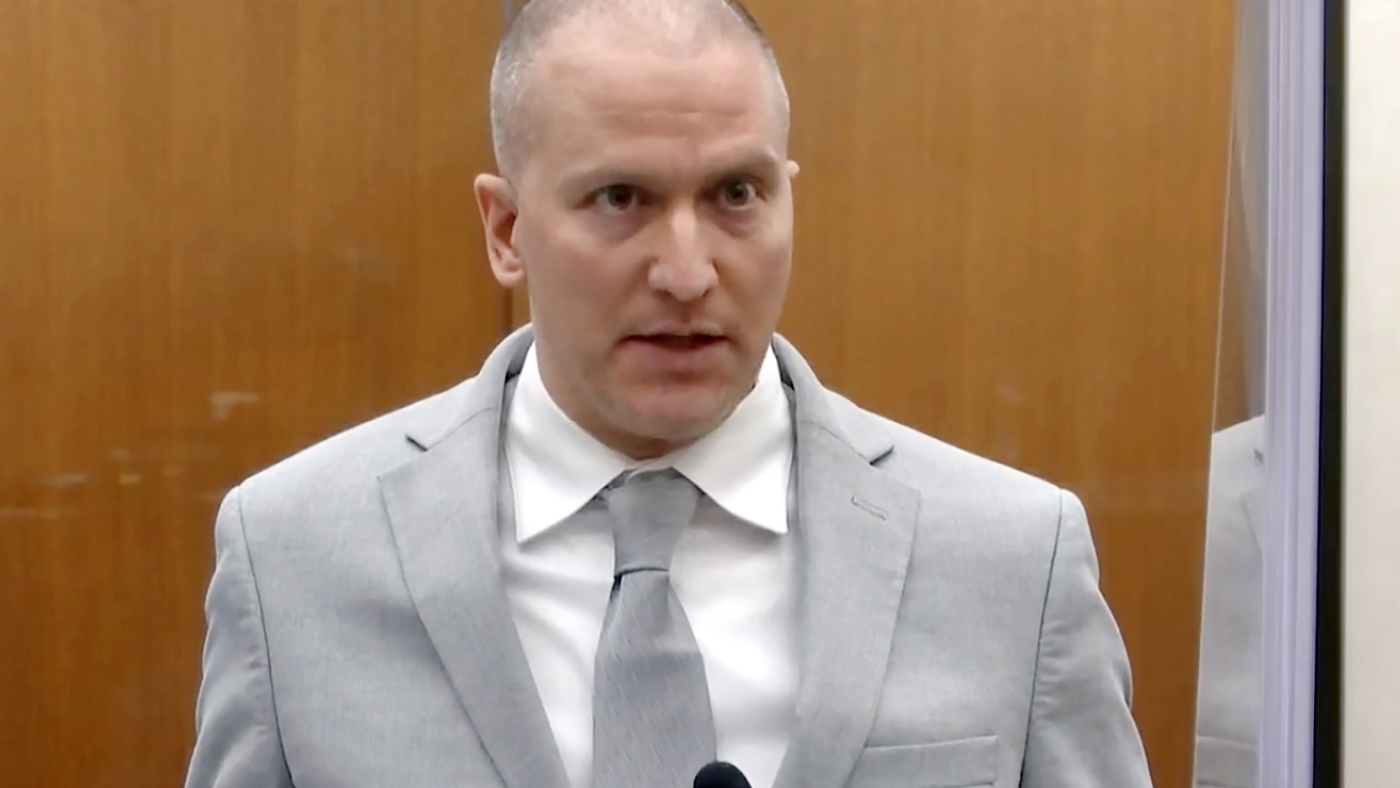
 News1 week ago
News1 week agoEx-officer convicted in George Floyd's killing is moved to new prison
-
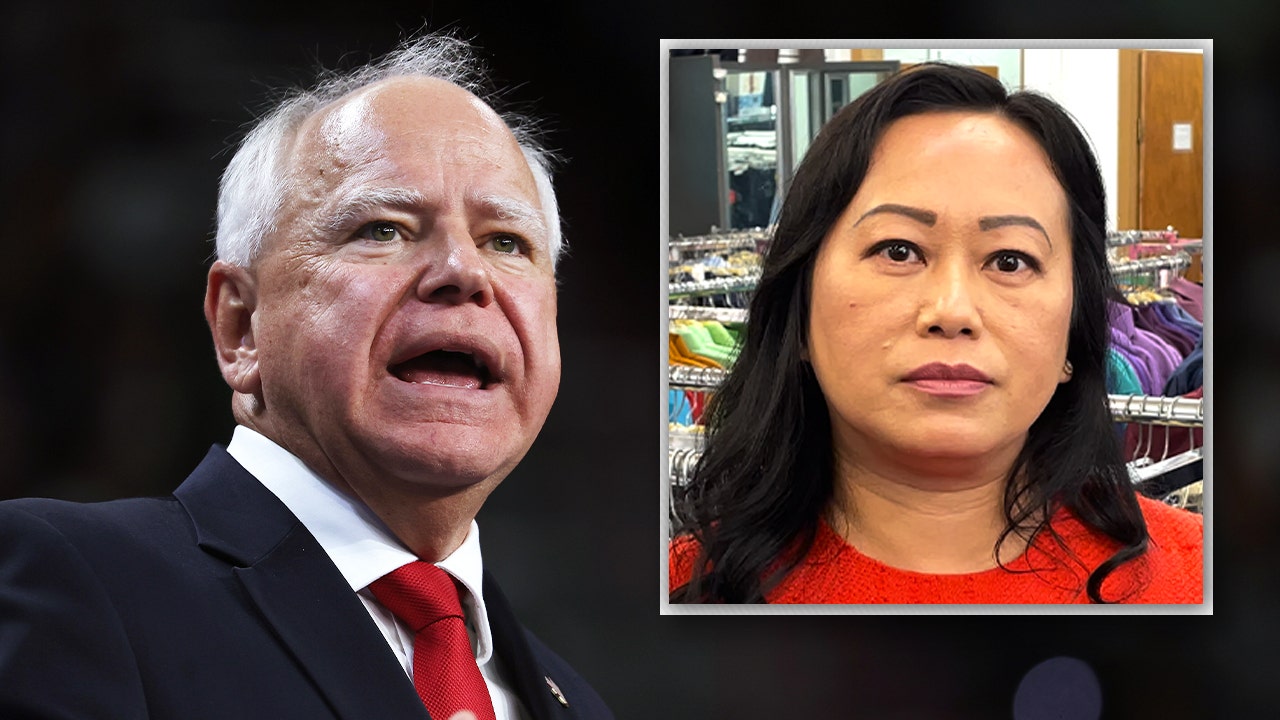
 Politics1 week ago
Politics1 week agoFormer teacher reveals which students suffered 'the most' under Walz's pandemic-era guidelines
-

 News1 week ago
News1 week agoVideo: D.N.C. Holds Enthusiastic Roll Call to Nominate Harris
-

 World1 week ago
World1 week agoPanama deports 29 Colombian migrants from Darien Gap under US deal



